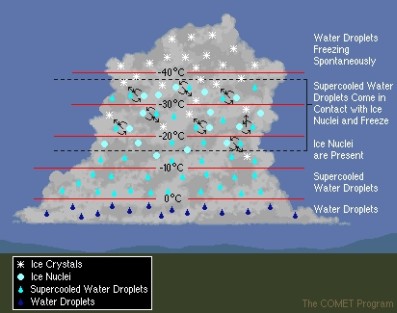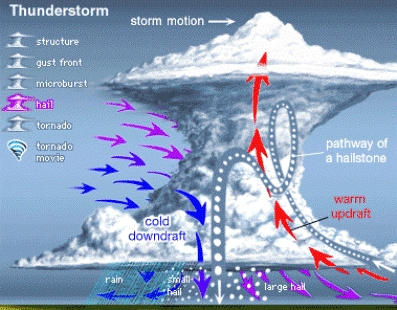Hail formation
 Hail is a form of solid precipitation, which is formed in thunderstorms clouds (Cumulonimbus).
Hail is a form of solid precipitation, which is formed in thunderstorms clouds (Cumulonimbus).
 Thunderstorms clouds consists of droplets of liquid water (at temperatures lower than 0°С, the droplets can be in a thermodynamically instable supercooled condition) and ice crystals. These clouds can reach up to 16-17 km in height in the mid-latitude of the Earth. Three layers are differentiated in their vertical structure: warm – a layer at a temperature of over 0°C, where there are droplets of liquid water only; supercooled, mixed – a layer at a temperature lower than 0°С, where there are droplets of liquid water and ice crystals, while the droplets content vastly decreases at the expense of crystals at temperatures lower than -20°С; cloud anvil – a layer at a temperature lower than -40°С , where there are ice crystals only.
Thunderstorms clouds consists of droplets of liquid water (at temperatures lower than 0°С, the droplets can be in a thermodynamically instable supercooled condition) and ice crystals. These clouds can reach up to 16-17 km in height in the mid-latitude of the Earth. Three layers are differentiated in their vertical structure: warm – a layer at a temperature of over 0°C, where there are droplets of liquid water only; supercooled, mixed – a layer at a temperature lower than 0°С, where there are droplets of liquid water and ice crystals, while the droplets content vastly decreases at the expense of crystals at temperatures lower than -20°С; cloud anvil – a layer at a temperature lower than -40°С , where there are ice crystals only.For more information:
• Severe Storms: online meteorology guide
• Thunderstorms
 For the hail precipitation formation, the following conditions are necessary:
For the hail precipitation formation, the following conditions are necessary:
- High supercooled liquid water content in the cloud
- Hail embryos: small frozen raindrops or soft ice particles known as grauple, which are hardened conglomerates of snow crystals.
- Strong updrafts.
For more information:
• Hail Basics
• Hail - wikipedia
• Hail Formation


